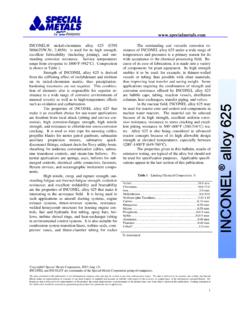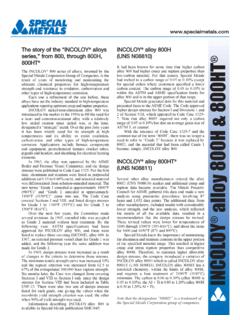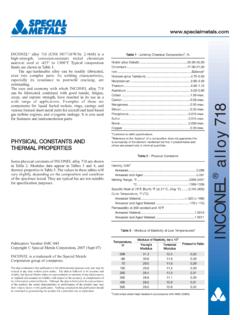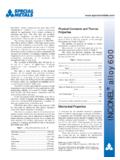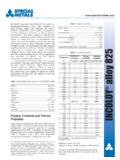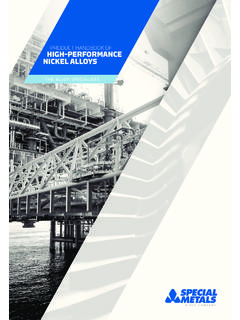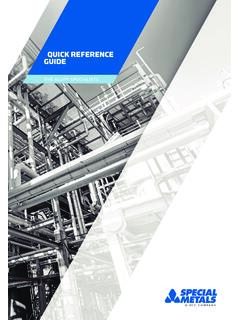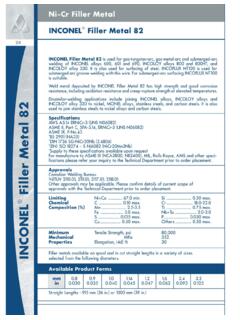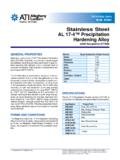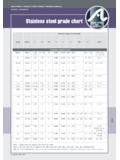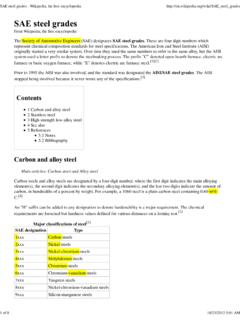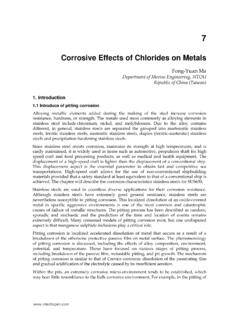Transcription of INCONEL alloy 625 - Special Metals Corporation
1 1 INCONEL alloy 625 INCONEL nickel-chromium alloy 625 (UNS N06625 ) is used for its high strength, excellent fabricability (including joining), and out-standing corrosion resistance. Service temperatures range from cryogenic to 1800 F (982 C). Composition is shown in Table 1. Strength of INCONEL alloy 625 is derived from the stiffening effect of molybdenum and niobium on its nickel-chromium matrix; thus precipitation - hardening treatments are not required. This combina-tion of elements also is responsible for superior re-sistance to a wide range of corrosive environments of unusual severity as well as to high-temperature effects such as oxidation and carburization. The properties of INCONEL alloy 625 that make it an excellent choice for sea-water applications are freedom from local attack (pitting and crevice cor-rosion), high corrosion-fatigue strength, high tensile strength, and resistance to chloride-ion stress-corrosion cracking.
2 It is used as wire rope for mooring cables, propeller blades for motor patrol gunboats, submarine auxiliary propulsion motors, submarine quick-disconnect fittings, exhaust ducts for Navy utility boats, sheathing for undersea communication cables, subma-rine transducer controls, and steam-line bellows. Po-tential applications are springs, seals, bellows for sub-merged controls, electrical cable connectors, fasteners, flexure devices, and oceanographic instrument compo-nents. High tensile, creep, and rupture strength; out-standing fatigue and thermal-fatigue strength; oxidation resistance; and excellent weldability and brazeability are the properties of INCONEL alloy 625 that make it interesting to the aerospace field. It is being used in such applications as aircraft ducting systems, engine exhaust systems, thrust-reverser systems, resistance-welded honeycomb structures for housing engine con-trols, fuel and hydraulic line tubing, spray bars, bel-lows, turbine shroud rings, and heat-exchanger tubing in environmental control systems.
3 It is also suitable for combustion system transition liners, turbine seals, com-pressor vanes, and thrust-chamber tubing for rocket The outstanding and versatile corrosion re-sistance of INCONEL alloy 625 under a wide range of temperatures and pressures is a primary reason for its wide acceptance in the chemical processing field. Be-cause of its ease of fabrication, it is made into a variety of components for plant equipment. Its high strength enables it to be used, for example, in thinner-walled vessels or tubing than possible with other materials, thus improving heat transfer and saving weight. Some applications requiring the combination of strength and corrosion resistance offered by INCONEL alloy 625 are bubble caps, tubing, reaction vessels, distillation columns, heat exchangers, transfer piping, and valves.
4 In the nuclear field, INCONEL alloy 625 may be used for reactor-core and control-rod components in nuclear water reactors. The material can be selected because of its high strength, excellent uniform corro-sion resistance, resistance to stress cracking and excel-lent pitting resistance in 500 -600 F (260-316 C) wa-ter. alloy 625 is also being considered in advanced reactor concepts because of its high allowable design strength at elevated temperatures, especially between 1200 -1400 F (649-760 C). The properties given in this bulletin, results of extensive testing, are typical of the alloy but should not be used for specification purposes. Applicable specifi-cations appear in the last section of this publication. Table 1 Limiting Chemical Composition, % min. max. Niobium (plus Tantalum).. max. max. max. max.
5 Max. max. max. max. aIf determined The data contained in this publication is for informational purposes only and may be revised at any time without prior notice. The data is believed to be accurate and reliable, but Special Metals makes no representation or warranty of any kind (express or implied) and assumes no liability with respect to the accuracy or completeness of the information contained herein. Alt-hough the data is believed to be representative of the product, the actual characteristics or performance of the product may vary from what is shown in this publication. Nothing contained in this publication should be construed as guaranteeing the product for a particular use or application. Copyright Special Metals Corporation , 2013 (Aug 13) INCONEL and INCOLOY are trademarks of the Special Metals Corporation group of companies.
6 2 INCONEL alloy 625 Physical Constants and Thermal Properties Some physical constants and thermal properties of IN-CONEL alloy 625 are shown in Tables 2 and 3. Low-temperature thermal expansion, based on measure-ments made by the National Bureau of Standards, is shown in Figure 1. Elevated-temperature modulus of elasticity data are given in Table 4. Table 2 Physical Constants Density, lb/cu Melting Range, Specific Heata, Btu/lb F (J/kg C) 0 F (-18 C).. (402) 70 F (21 ).. (410) 200 F (93 C).. (427) 400 F (204 C).. (456) 600 F (316 C).. (481) 800 F (427 C).. (511) 1000 F (538 C).. (536) 1200 F (649 C).. (565) 1400 F (760 C).. (590) 1600 F (871 C).. (620) 1800 F (982 C).. (645) 2000 F (1093 C).. (670) Permeability at 200 Oersted ( kA/m).. Curie Temperature, <-320 aCalculated Figure 1 Thermal Expansion at Low Temperatures Table 3 Thermal and Electrical Properties Temp.
7 F Meal Linear Expansiona 10-6in/in F Thermal Conductivityb,c Btu in/ft2-h F Electrical Resistivityc ohm-circ mil/ft Temp C Mean Linear Expansiona m/ m C Thermal Conductivity b,c W/m C Electrical Resistivityc -cm -250 - 50 - -157 - - -200 - 52 - -129 - - -100 - 58 - -73 - - 0 - 64 - -18 - - 70 - 68 776 21 - 129 100 - 70 780 38 - 130 200 75 794 93 132 400 87 806 204 134 600 98 812 316 135 800 109 818 427 136 1000 121 830 538 138 1200 132 830 649 138 1400 144 824 760 137 1600 158 818 871 136 1700 - - 927 - - 1800 - 175 812 982 - 135 2000 - - 806 1093 - - 134 bMeasurements made at Battelle Memorial Institute cMaterial annealed 2100 F/1 hr aFrom 70 F to temperature shown 3 INCONEL alloy 625 Table 4 Modulus at Elevated Temperaturesa Temp.
8 F Modulus of Elasticity, 103 ksi Poisson s Ratio Temp. C Modulus of Elasticity, GPa Tension Shear Tension Shear Annealed Solution- Treated Annealed Solution- Treated Annealed Solution- Treated Annealed Solution- Treated Annealed Solution- Treated 70 21 200 93 400 204 600 316 800 427 1000 538 1200 649 1400 760 1600 871 aDetermined dynamically on samples from -in. hot-rolled rod. Mechanical Properties Nominal room-temperature mechanical properties of INCONEL alloy 625 are shown in Table 5. For service at 1200 F and below, hot-finished, cold-finished, and annealed conditions (depending on requirements involved) are recom-mended. For service above 1200 F, either annealed or solution-treated material will give best service.
9 The solution-treated condition is recommended for components that require optimum resistance to creep or rupture. Fine-grained (annealed) material may be advantageous at temperatures up to 1500 F with re-spect to fatigue strength, hardness, and tensile and yield strength. MacGregor s two-load was used for deter-mination of the true stress-strain curve for alloy 625 at room temperature. The two-load test requires no strain measurement during the test, and only the maximum and fracture loads are recorded. Data for both annealed and solution-treated material are shown in Figure 2. Figure 2 True stress-true strain of round. Table 5 Nominal Room-Temperature Mechanical Propertiesa Form And Condition Tensile Strength Yield Strength ( Offset) Elongation Reduction Of Area Hardness, Brinell ksi MPa ksi MPa % % ROD, BAR, PLATE As-Rolled 120-160 827-1103 60-110 414-758 60-30 60-40 175-240 Annealed 120-150 827-1034 60-95 414-655 60-30 60-40 145-220 Solution-Treated 105-130 724-896 42-60 290-414 65-40 90-60 116-194 SHEET and STRIP Annealed 120-150 827-1034 60-90 414-621 55-30 - 145-240 TUBE and PIPE, COLD-DRAWN Annealed 120-140 827-965 60-75 414-517 55-30 - - Solution-Treated 100-120 689-827 40-60 276-414 60-40 - - aValues shown are composites for various product sizes up to 4 in.
10 They are not suitable for specification purposes. For properties of larger-sized products, consult Special Metals Corporation . 4 INCONEL alloy 625 Tensile Properties and Hardness Typical tensile properties of annealed and solution-treated material from room to elevated temperature are shown in Figures 3, 4, and 5. The approximate relationship between the hardness and tensile and yield strength of strip is shown in Figure 6. Increased tensile properties for service at moderate temperature can be achieved by cold work. See the section, Working Instructions for some specific data. Upon exposure to intermediate tempera-tures, some hardening takes place in alloy 625. To demonstrate this reaction, samples of annealed rod were exposed to 1200 , 1400 , and 1600 F for 2000 hours. The effect of exposure on properties both at room temperature and at exposure temperature is shown in Table 6.

